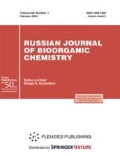Abstract
Possibilities and limitations of the method of examination of proteolytic enzymes’ primary specificity by statistical analysis of MALDI (matrix-assisted laser desorption/ionization) mass spectra of products obtained by protein substrate proteolysis, without direct determination of their amino acid sequences, were investigated theoretically. The optimum range given by the measurement errors of the peptides’ masses for obtaining a statistical set of the events, and the form of statistical data presentation, were chosen. It was shown that the proposed method can be applied only for proteases with a relatively narrow primary specificity (two or three amino acids). The influence of protein substrate molecular weight and amino acid composition on the efficiency of specifics for a particular protease amino acid, revealed under statistical treatment of the set of proteolysis product masses, was studied on the model of trypsin, chymotrypsin, glutamylendopeptidase, pepsin (pH 1.3).
Similar content being viewed by others
References
Schechter, J. and Berger, A., Biochem. Biophis. Res. Communs., 1967, vol. 27, pp. 157–162.
Klesov, A.A., Fermentativnyi kataliz (Enzymatic Catalysis), Moscow: Izd. Mosk. Gos. Univ., 1984, vol. 2.
Collins, P.J., McMahon, G., O’Brien, P., and O’Connor, B., Int. J. Biochem. Cell Biol., 2004, vol. 36 P, pp. 2320–2333.
Guionie, O., Moallic, C., Niamker, S., Placier, G., Sine, J.-P., and Colas, B., Comp. Biochem. Physiol., 2003, vol. 135, pp. 503–510.
Baskova, I.R. and Zavalova, L.L., Biochemistry (Moscow), 2007, vol. 72, no. 2, pp. 270–278.
Celia, P. and Milstein, D.E.V., Deverson, Biochem. J., 1971, vol. 123, pp. 945–958.
Nolan, C., Margoliash, E., Peterson, J.D., and Steiner, D.F., J. Biol. Chem., 1971, vol. 246, pp. 2780–2791.
Shilling, O. and Overall, C.M., Nature Biotechnol., 2008, vol. 26, pp. 585–594.
Keller, U., Auf Dem, Schilling O, Biochimie, 2010, vol. 92, pp. 1705–1714.
Keller, U., Auf Dem, Schilling O, Overall C. M, Methods Mol. Biol., 2011, vol. 753, pp. 257–272.
Zinchenko, A.A., Rumsh, L.D., and Antonov, V.K., Bioorg. Khim., 1976, vol. 2, pp. 803–810.
Roepstorff, P., Proteomics in Functional Genomics: Protein Structure Analysis, Jolles, P. and Jornvall, H., Eds., Basel: Birkhauser Verlag AC, 2000.
Bernd, O. and Keller, LiangLi., J. Am. Soc. Mass Spectrom., 2000, vol. 11, pp. 88–93.
Sungurov, Yu.V., Eremeev, N.L., Lebedev, A.T., Maloshitskaya, O.A., Rudenskaya, G.N., and Semenova, S.A., Russ. J. Bioorg. Chem., 2008, vol. 34, pp. 353–358.
Sungurov, Yu.V., Eremeev, N.L., Lebedev, A.T., Maloshitskaya, O.A., Rudenskaya, G.N., and Semenova, S.A., Mass-Spektrometriya, 2008, vol. 5, no. 4, pp. 259–266.
Sungurov, Yu.V., Eremeev, N.L., Lebedev, A.T., Maloshitskaya, O.A., Rudenskaya, G.N., Semenova, S.A., and Shmoylov, A.M., in Research Progress in Biotechnology, Zaikov, G.E., Ed., New York: Nova Science Publ., 2008.
Gay, S., Binz, P.A., Hochstrasser, D.F., and Appel, R.D., Electrophores, 1999, vol. 20, no. 18, pp. 3527–3534.
Tabb, D.L., MacCoss, M.J., Wu, C.C., Anderson, S.D., and Yates, J.R., Anal. Chem., 2003, vol. 75, no. 10, pp. 2470–2477.
Wolski, W.E., Farrow, M., Emde, A., Lehrach, H., Lalowski, M., and Reinert, K., Proteome Sci., 2006, vol. 4, p. 18.
Author information
Authors and Affiliations
Corresponding author
Additional information
Original Russian Text © M.I. Drachevskaya, A.V. Borzenkova, N.L. Eremeev, 2012, published in Bioorganicheskaya Khimiya, 2012, Vol. 38, No. 1, pp. 111–118.
Rights and permissions
About this article
Cite this article
Drachevskaya, M.I., Borzenkova, A.V. & Eremeev, N.L. Theoretical possibilities and limitations of protease primary specificity determination by statistical analysis of MALDI mass-spectra of proteolysis products. Russ J Bioorg Chem 38, 93–99 (2012). https://doi.org/10.1134/S1068162012010049
Received:
Accepted:
Published:
Issue Date:
DOI: https://doi.org/10.1134/S1068162012010049




